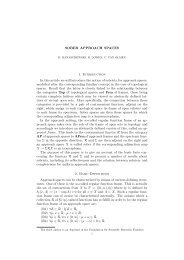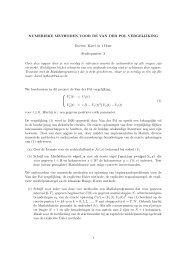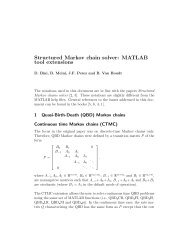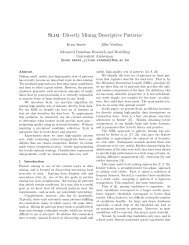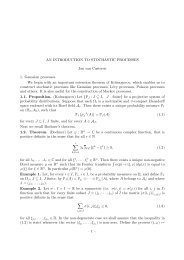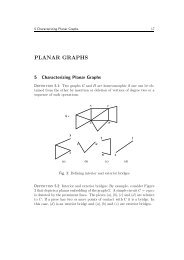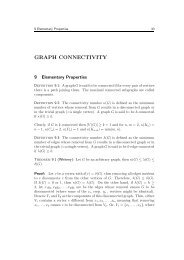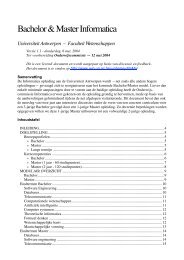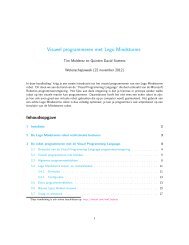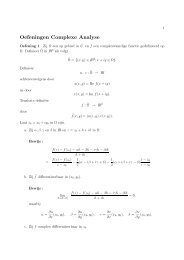Practical Rational Interpolation of Exact and Inexact Data Theory ...
Practical Rational Interpolation of Exact and Inexact Data Theory ...
Practical Rational Interpolation of Exact and Inexact Data Theory ...
You also want an ePaper? Increase the reach of your titles
YUMPU automatically turns print PDFs into web optimized ePapers that Google loves.
8 1. Classical rational interpolation<br />
valuable computational tool for three reasons. First <strong>of</strong> all, the condition<br />
number <strong>of</strong> V<strong>and</strong>ermonde-like matrices grows exponentially with n [GI87],<br />
such that the obtained coefficients <strong>of</strong> p(x) <strong>and</strong> q(x) may be very inaccurate.<br />
Changing to orthogonal basis polynomials is necessary for improving<br />
the conditioning <strong>of</strong> the problem. Second, there is the normalization. Usually,<br />
an a priori normalization is agreed upon for one <strong>of</strong> the coefficients in<br />
the numerator or denominator polynomial. Although an appropriate normalization<br />
can always be found, choosing an inappropriate normalization<br />
for the problem at h<strong>and</strong> may cause the linear system to be inconsistent.<br />
Third, if the homogeneous system is not <strong>of</strong> full rank <strong>and</strong> the nullspace is<br />
therefore multidimensional, finding a representation for the minimal degree<br />
solution from a basis for the nullspace is not obvious. If the obtained couple<br />
(p(x),q(x)) is not the minimum degree solution, then it may happen that<br />
both p(xi) = q(xi) = 0 for some xi ∈ Xn, while after cancellation <strong>of</strong> (x −xi)<br />
nonetheless p(xi)/q(xi) = fi. This complicates the practical detection <strong>of</strong><br />
unattainable points.<br />
Example 1.3.1. As an example, consider the data xi = i+1 <strong>and</strong> fi = 1/xi<br />
for i = 0,... ,4 <strong>and</strong> let ℓ = m = 2. The rational interpolant for these data<br />
is rℓ,m(x) = 1/x. Let us consider a solution <strong>of</strong> (1.2) in classical powerform.<br />
A popular normalization is β0 = 1. With this normalization, the linear<br />
system (1.2) is inconsistent, although the rational interpolation problem has<br />
a solution. Without normalization, the system (1.2) for these data is rank<br />
deficient by one, <strong>and</strong> its kernel (or nullspace) is therefore two dimensional.<br />
All solutions <strong>of</strong> (1.2) are parameterized as follows α2 = 0 = β0, α1 = β2,<br />
α0 = β1. Hence all solutions <strong>of</strong> (1.2) are polynomials <strong>of</strong> the form p(x) =<br />
α0 + α1x <strong>and</strong> q(x) = x(α0 + α1x). If we choose for example α0 = −α1 = 0,<br />
then both p(x) <strong>and</strong> q(x) contain the factor (x − 1) = (x − x0). Although x0<br />
is not unattainable, both p(x0) <strong>and</strong> q(x0) vanish.<br />
Due to such difficulties, solving (1.2) directly is not recommended. A<br />
more convenient alternative are recursive algorithms that build up consecutive<br />
interpolants along a path in the table <strong>of</strong> rational interpolants, which is<br />
defined below.<br />
In a strictly formal sense, consider the infinite, fixed sequence {xn} ∞ n=0 .<br />
For different values <strong>of</strong> ℓ + m = n, the rational interpolants <strong>of</strong> order (ℓ,m)



